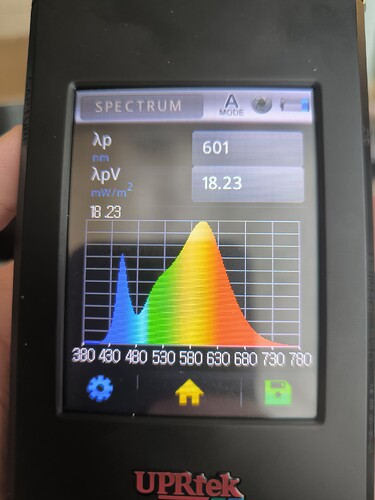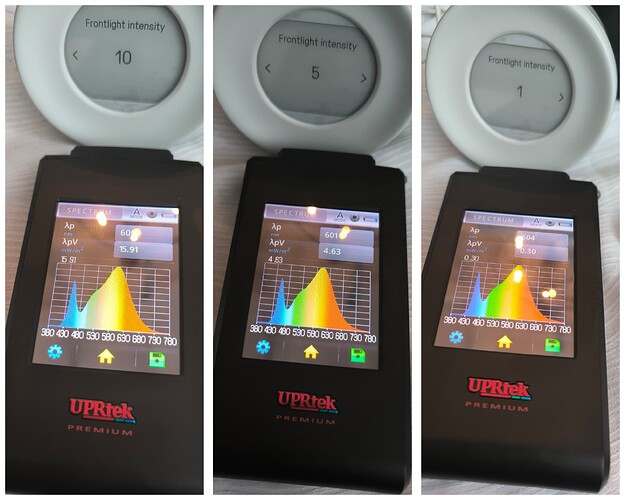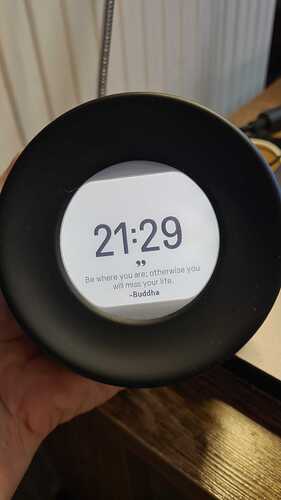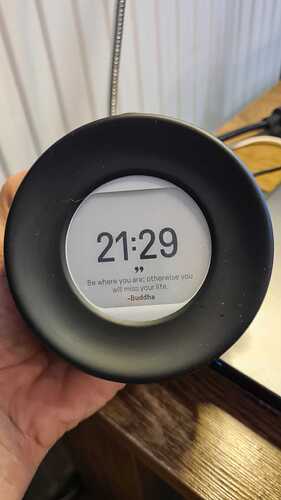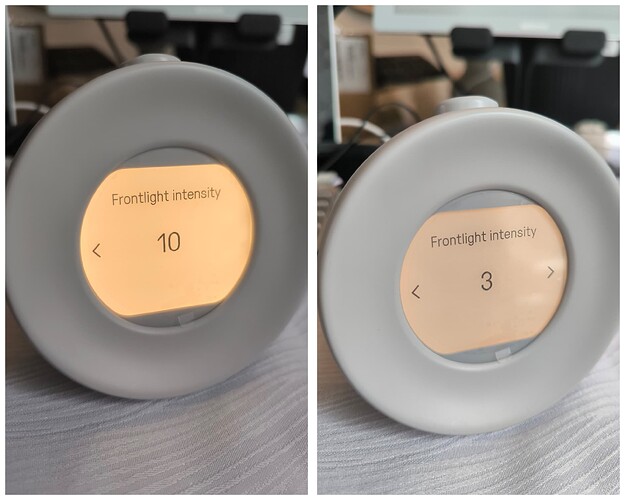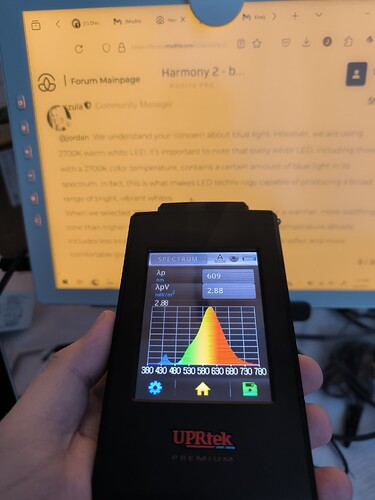So I just got a harmony 2 today and decided to test it’s color spectrum. I’m surprised to see it emits a lot of blue light. Enough to be circadian disrupting. I’m assuming this has a row of white LEDs and also warm colored LEDs inside that give it the mixed color temp appearance. Is there a way to force it all orange without white ?
Thanks for the info. I have the first Harmony, but I believe I have the same issue. It is a bit strange because the Harmony 2 page says " Minimal blue light. Prevents eye strain by minimizing blue light exposure".
I’m wondering if the same will happen with Kompakt. I’m trying to minimize my exposure to blue light as much as possible, and I was still considering having it as part of my daily routine, but it seems to be harder than I expected.
Wow this is not good
Thank you for sharing this @jordan
I have passed this on to our team. I am wondering was the front-light FULLY on at the max level when you took this measurement?
What was the setting?
Here are the measurements at different brightness levels. I tested with my light sensor directly against the display.
If there was some toggle, maybe a “circadian friendly” toggle that would disable the white LEDs, only leaving the amber LEDs enabled that would be awesome. That’s if my assumption is correct with you guys using WLED + amber LEDs with the current function. If there is no control over those LEDs with the harmony 2, I hope the kompakt will have that function ![]()
@jordan Thanks for the pix. Maybe it’s the way the camera takes the pix, but I can’t see the difference between the light intensity on the Harmony device screen. (the way it looks on my screen)
The picture above didn’t have the front light on, it timed out by the time I took the photo.
Here is what mine looks like with the light on
@jordan We understand your concern about blue light. However, we are using 2700K warm white LED. it’s important to note that every white LED, including those with a 2700K color temperature, contains a certain amount of blue light in its spectrum. In fact, this is what makes LED technology capable of producing a broad range of bright, vibrant whites.
When we selected 2700K LEDs for our device, we aimed for a warmer, more soothing tone than higher Kelvin values would offer. This lower color temperature already includes less blue light than cooler white options, providing a softer and more comfortable glow.
Yeah this makes sense, as long as its a low level of blue light which it is
The thing is that it’s a little lower blue light vs a cool white led but still it’s not considered “low blue light”
I’ll just use my harmony 2 without the front light but I hope for any future products that you guys can get rid of blue light because there are better led options out there ![]()
I just avoid all circadian disrupting lighting.
This is my dasung 13.3 eink monitor warm front light. You can see the blue light is FAR less than the harmony 2 and also has pretty much the same appearance.
I SO appreciate you making this post!! Also, may I ask how you got your light to be so warm tinted? It may just be the light. I turned my Harmony 2 on and yours seems warmer in comparison.
I guess there’s no way that a software update would be able to solve this since it’s the actual lights in the clock. Last I was told, there may be limitations to change it since it’s the actual bulbs, but I too had raised the points about allowing warmer tones at night. I agree. I wish there was less blue light, especially at night. Every now and then I wake up in the middle of the night and want to know what time it is, so I squint – even with my clock brightness down and it’s just so hard on the eyes in a dark room.
As per sleepfoundation.org:
“Warm hues of red, orange, and yellow are better for preparing the mind and body for sleep. In fact, some experts recommend switching to warm lights rather than cold blue lights in the home after the sun goes down. Different colors of warm light from red to yellow can affect the body in unique ways…”
“Red light does not affect circadian rhythms, so it is one of the best lights to use at night. Research has shown that exposure to red light can improve sleep and increase the production of melatonin. Exposure to red light during sleep and upon waking can reduce the likelihood of feeling tired and disoriented in the morning, known as sleep inertia. However, if the red light is too bright, it can suppress melatonin production.”
“Dim yellow and orange colored lights have little impact on the circadian rhythm and are good options to use at night. Exposure to this light may increase melatonin production, especially compared to cooler colors such as blue light.”
" Light receptors in the eye that affect the circadian rhythm are particularly sensitive to blue light. Blue light not only suppresses melatonin, it also enables the circadian rhythm to help the body maintain alertness. Regularly viewing blue light at night convinces the body that it is still daytime, which can disrupt the circadian rhythm and reduce sleep quality."
“Blue light is emitted from many artificial lights and electronic screens, such as cell phones, computers, and televisions. Avoid using electronic devices that emit blue light at least one hour before bed.”
Source: What Color Light Helps You Sleep? | Sleep Foundation
I figured this would be great to quote for this discussion. I learned something new! I did not know red light was helpful. We all know the warmer tones or orange/yellow tones associated with smartphones. So, ideally, it would be amazing if next Mudita clocks had the option to even have a red tint. You can change it between red or yellow/orange. Even if the screen had a slight yellow tint instead of blue, ever so slight,it might be nicer on the eyes. I would love that! Mudita-- if you’re reading, this would be so amazing!!
Love love love this! Yeah, this would be amazing for the Mudita Harmony 3. And then we can have this during the day, we can set when the light changes for at night to a red or yellow-orangish tint at night. I wonder if Mudita would be upset if I photoshopped what I was thinking. I’m so inspired to do it just to see.
I do want to commend this choice. 2700k warm white LED lights emit very little electromagnetic radiation. Google does say that this type is supposed to produce not much blue light and are considered the safest. So, with that in mind, not sure what LED the dasung 13.3 eink monitor uses. Not sure if Mudita can get their hands on making something like this. I visited the website and it looks like the front light they use in their devices is exclusively made for them.
You’re welcome!! My clock just was this color as is hmm… is yours the lighter or the black one? maybe they use different color leds depending on the color? I noticed urszula’s looked much cooler color temp than mine but hers is black. The only way I can see it being possible if they’re blending white and orange leds together and they allowed us to control the brightness of each type of leds like other eink device do but if theyre all wired to the same circuit then it would definitely be impossible. Only way to change it would be to solder different leds to it which would be a very hard task since all that is small surface mounted stuff.
I myself am always trying to stay away from blue light as much as I can. The benefits from respecting circadian rhythm is soooo worth it. I use to think it was fluff because my prescription glasses with blue blockers added to them didnt give me any noticeable improvements. I later found out that the blue block coating doesnt actually block blue like I thought they would which explains why I saw no improvements. best is to wear orange/red lenses or to stay around orange or red lighting without that blue peak like the harmony clock has. I personally use incandescent lighting only in my house as the color spectrum is the literal best but wouldnt be possible in a alarm clock sadly lol.
hmm I know there are pfs or kfs phosphor LEDs which are more reddish. I forgot if one is more towards orange. Its not exclusively for dasung since I know the circadian friendly tablet “Daylight DC1” either uses those or those + YAG phosphor leds but they allow you to adjust the color temp to cut out all blue.
Mine is black. That’s weird though, you’d expect that despite the color of the exterior, the internal light would be the same. Or, that’s what I thought.
Yeah, unfortunately, it looks like it may not be possible for the Harmony 2, which is why I’m wondering if Mudita would be willing to do some sort of trade-in program if and when they create a Harmony 3. I’m sure there’s still people who would want the 2. I just purchased my Mudita clock the end of last year and even though I’m super happy with my purchase and I think it was worth the investment, this was definitely pricey for me and I probably would have waited if I knew a version would come out in the future with this ability of controlling brightness of difference bulbs (if it were to come) and maybe even possibly multiple alarms.
Ah, me too! I also try and stay away from blue lighting. I hear what you’re saying. I went to an optomistrist to get prescription glasses and he was telling me how blue-light glasses is all marketing and doesn’t really do much. So, I’m not surprised that orange/red lenses work. I will also be practicing incandescent lighting only when I move into a place of my own.
Hopefully in the future, Mudita could give us both white and orange bulbs in the next Harmony clocks. I know they got a lot on their plate with Kompakt, but maybe after a years worth time, they’ll be able to focus on their other products as well. Would love to see it!
Right! I would expect them to have the exact same internals. thats so weirddd. maybe someone can confirm from mudita?
Trade in sure would be nice but I doubt they would ![]() it definitely is pricey I have been holding out for a long time to find a deal. I got mine from someone for $80 luckily. I plan to use my kompakt mostly without the front light but it would sure be nice to have a light that is blue light free for when I do use the front light sometimes.
it definitely is pricey I have been holding out for a long time to find a deal. I got mine from someone for $80 luckily. I plan to use my kompakt mostly without the front light but it would sure be nice to have a light that is blue light free for when I do use the front light sometimes.
Niceee. Yeah they’re just taking advantage of people tbh on blue blocking add ons, I tested my old glasses and was shocked how little they touched blue light lol. Orange and red completely block it but I dont wear them since I got good lighting indoors. Right on! I know incandescent lighting could be hard to find as well but I think the ban was just lifted. I have a stock pile of incandescents I collected the last two years from stores that still had them.
It would be nice if they can have two options to switch from! or like a slider option that you can change with the top knob where 0 is white and 10 is amber, anything between is a mixture of both while 0 is pure white and 10 is pure amber
Yeah, the turning of the knob would be cool. Similarly to how you can set volume currently, I would like to set the mixture, but most importantly. Have some sort of set time that it begins and ends.
Maybe I’m spoiled with so many apps and phones that do the automatic change from white background with black text to black background to white text screens on computers and phones. However, that’s what I would want with my Mudita Harmony clock. I’d want my clock to have a red-orange hue at night that automatically begins by the time I set it to. I can use the knob to select intensity. Then, it won’t change back until either the end time I set or the beginning time of the daytime. I’m not sure which way works best, but that way it will always be better on the eyes at night.
Basically, if it can’t turn on between certain hours that I choose, then have it programmed at a certain time. But yeah, it would be nice to be able to manually customize not only when it begins and what intensity, but ability to do that for both the “main” hue as well as the secondary hue. I hope that made sense.
Oh yes I so agree with that! That would be so much better and I dont think it would be that hard to implement. I hope mudita hears us!! ![]()
Thanks @jordan
People reading this thread may enjoy the detailed information here: Extreme spectrum-based light sensitivity and mudita products
I look forward to us finding ways to adapt Mudita’s devices to solve this.
No problem!
I was thinking and remembered they sell colored overlay clings which are adhesive backed, we could stick them over the clocks display to maybe filter out the blue using a orange one maybe? I see they show orange in the pic but on the drop down I don’t see it. Maybe listing error but I guess the next issue is how would we cut it to fit nicely hmm… if we could remove the round front bezel then we could cut it as a square and snap it back on but I don’t think it removes that easily ![]()
